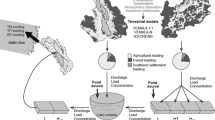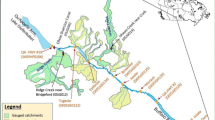Abstract
The Cahaba River, a sixth-order stream, tributary to the Mobile-Alabama River, is one of the few free-flowing rivers in Alabama. The Cahaba River lies in north-central Alabama and its watershed includes a variety of land uses from forested and agricultural to urban. Water quantity and quality modeling of the Cahaba River using several modules of the hydrologic simulation program FORTRAN (HSPF) and the nonpoint source model (NPSM) using the GIS-based BASINS package showed good agreement with measured flow data for low- and high-flow years but poor agreement with total nitrogen concentrations in the water column. Disparities between modeling and measured water quality data are attributed to the limited point source data available for nitrogen inputs to the stream and the lack of nitrogen-transformation process modeling with the NPSM. Future simulations should include use of models with detailed nitrogen transformation modules.












Similar content being viewed by others
References
Arbuckle KE, Downing JA (2001) The influence of watershed land use on lake N:P in a predominantly agricultural landscape. Limnol Oceanogr 46:970–975
Beaulac MN, Reckhow KH (1982) An examination of land use-nutrient export relationships. Water Resour Bull 18:1013–1024
Cahaba River Society (1997) Cahaba: a gift for generations. Birmingham Printing and Publishing Company, Birmingham, Alabama
Caraco NF, Cole JJ (1999) Human impact on nitrate export: an analysis using major world rivers. Ambio 28:167–170
Carey AE, Nezat CA, Pennock JR, Jones T, Lyons WB (2003) Nitrogen budget of the Mobile-Alabama River system watershed. Geochemistry: Exploration, Environment, Analysis. 3:239–244
Carpenter SR, Caraco NF, Correll DL, Howarth RW, Sharpley AN, Smith VH (1998) Nonpoint pollution of surface waters with phosphorus and nitrogen. Ecol Appl 8:559–568
Correll DL, Jordan TE, Weller DE (1992) Nutrient flux in a landscape: effects of coastal land use and terrestrial community mosaic on nutrient transport to coastal waters. Estuaries 15:431–442
Correll DL, Jordan TE, Weller DE (1999) Transport of nitrogen and phosphorus from Rhode River watersheds during storm events. Water Resour Res 35:2513–2521
Dillon PJ, Kirchner WB (1975) The effects of geology and land use on the export of phosphorus from watersheds. Water Res 9:135–148
Donigian AS, Crawford NH (1976) Modeling nonpoint pollution from the land surface, EPA-600/3-76-083. US Environmental Protection Agency, Athens, Georgia
Donigian AS, Davis HH (1978) User's manual for agricultural runoff management (ARM) model, EPA-600/3-78-080. US Environmental Protection Agency, Athens, Georgia
Galloway JN, Schlesinger WH, Levy H II, Michaels A, Schnoor JL (1995) Nitrogen fixation: anthropogenic enhancement—environmental response. Global Biogeochem Cycles 9:235–252
Hill AR (1978) Factors affecting the export of nitrate-nitrogen from drainage basins in southern Ontario. Water Res 12:1045–1057
Howarth RW, Billen G, Swaney D, Townsend A, Jaworski N, Lajtha K, Downing JA, Elmgren R, Caraco N, Jordan T, Berendse F, Frene J, Kudeyarov V, Murdoch P, Zhu Z-L (1996) Regional nitrogen budgets and riverine N and P fluxes for the drainages to the North Atlantic Ocean: natural and human influences. Biogeochemistry 35:735–139
Jordan TE, Correll DL, Weller DE (1997a) Effects of agriculture on discharges of nutrients from coastal plain watersheds of Chesapeake Bay. Environ Qual 26:836–848
Jordan TE, Correll DL, Weller DE (1997b) Nonpoint source discharge of nutrients from piedmont watersheds of Chesapeake Bay. J Am Water Resour Assoc 33:631–645
Jordan TE, Correll DL, Weller DE (1997c) Relating nutrient discharges from watersheds to land use and streamflow variability. Water Resour Res 33:2579–2590
King PB (1969) The tectonics of North America: a discussion to accompany the tectonic map of North America, scale 1:5,000,000. US Geol Survey Prof Pap 901, USGS
Lahlou M, Shoemaker L, Choudhury S, Elmer R, Hu A (1998) Better assessment science integrating point and nonpoint sources, BASINS, version 2.0 user's manual. EPA-823-R-98-006. US Environmental Protection Agency, Athens, Georgia
Lowrance R, Todd R, Fail J Jr, Hendrickson O Jr, Leonard R, Asmussen L (1984) Riparian forests as nutrient filters in agricultural watersheds. BioScience 34:374–377
Lydeard C, Mayden RL (1995) A diverse and endangered aquatic ecosystem of the southeast United States. Conserv Biol 9:800–805
McMahon G, Harned DA (1998) Effect of environmental setting on sediment, nitrogen, and phosphorus concentrations in Albemarle-Pamlico drainage basin, North Carolina and Virginia, USA. Environ Manage 22:887–903
Nix SJ, Odem WI, Voepel H, Davis DP, Deskins AD (1999) A watershed model for developing total maximum daily loads (TMDLs) for nutrients in Oak Creek, Arizona. Arizona Department of Environmental Quality, Phoenix, Arizona
Roberson JA, Cassidy JJ, Chaudury MH (1995) Hydraulic engineering. Wiley, New York
United States Geological Survey (1998) National water-quality assessment program: Mobile River Basin. USGS fact sheet FS-100-98
Vanni MJ, Renwick WH, Headworth JL, Auch JD, Schaus MH (2001) Dissolved and particulate nutrient flux from three adjacent agricultural watersheds: a five-year study. Biogeochemistry 54:85–114
Vitousek PM, Aber J, Howarth RW, Likens GE, Matson PA, Schindler DW, Schlesinger WH, Tilman D (1997) Human alteration of the global nitrogen cycle: causes and consequences. Issues Ecol, vol 1, Spring 1997
Ward AK, Ward GM, Harris SC (1992) Water quality and biological communities of the Mobile River drainage, eastern Gulf of Mexico region. In: Becker CD, Neitzel DA (eds) Water quality in North American river systems. Battelle Press, Columbus, Ohio, pp 277–304
Water Improvement Commission (WIC) (1974) Water quality management plan: Cahaba River basin. Submitted in accordance with Section 303(e) of the federal water pollution control act, as Amended, 1972
White FM (1979) Fluid Mechanics. McGraw-Hill, New York, 701 pp
Acknowledgements
The authors would like to thank S. Rocky Durrans, W. Berry Lyons, John J. Warwick and William Thomas for their input into the implementation of this model and their helpful comments and criticisms as the work progressed. Thanks to Elisabeth L. Sikes for her comments, which greatly improved the original manuscript. This research was supported by R/ER-46-PD grant # NA86RG0039 from the Mississippi-Alabama Sea Grant Consortium. The University of Alabama's Environmental Institute provided partial funding to DNE for this research.
Author information
Authors and Affiliations
Corresponding author
Rights and permissions
About this article
Cite this article
El-Kaddah, D.N., Carey, A.E. Water quality modeling of the Cahaba River, Alabama. Env Geol 45, 323–338 (2004). https://doi.org/10.1007/s00254-003-0890-2
Received:
Accepted:
Published:
Issue Date:
DOI: https://doi.org/10.1007/s00254-003-0890-2




